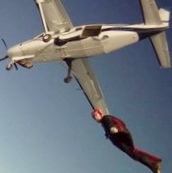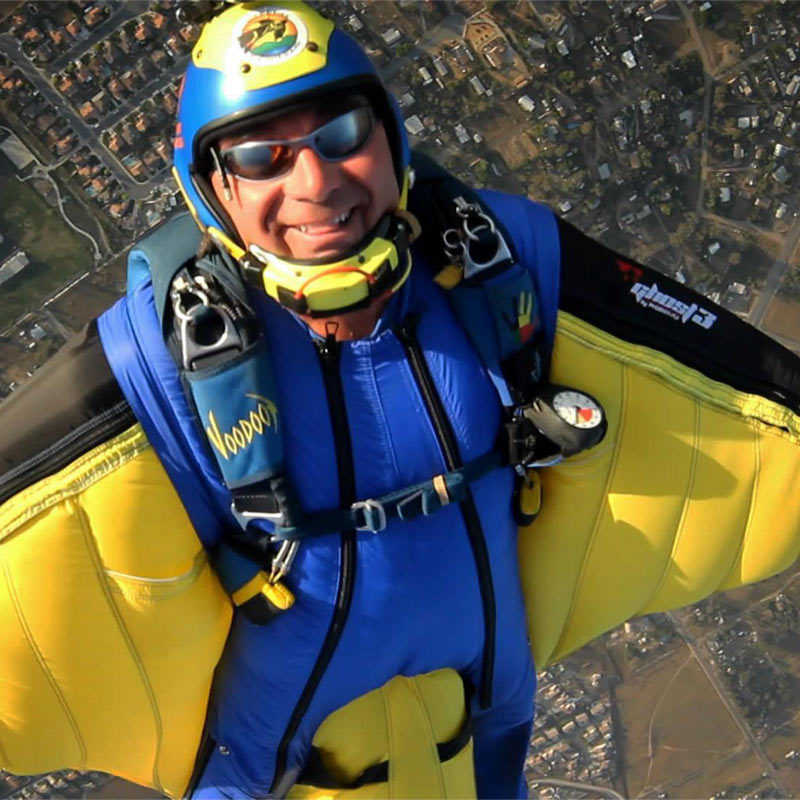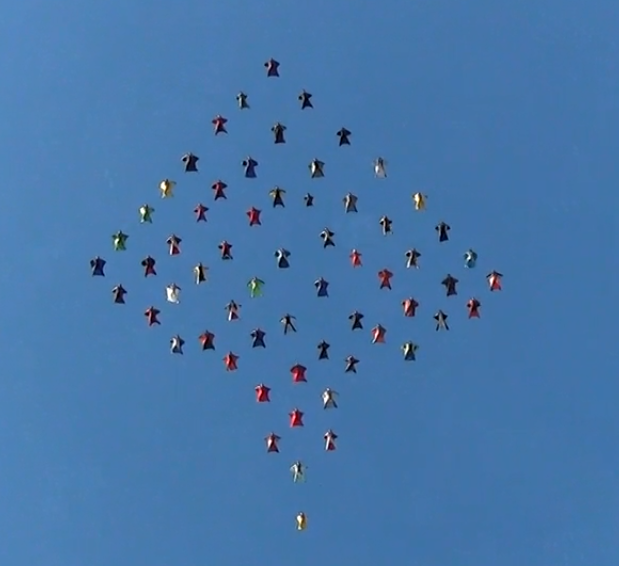Recommended Posts
Para5-0 0
As for me and my house, we will serve the LORD...
Bolas 5
QuoteI hope everyone realizes that this is where the decisions already reside. If DZO's and S&TA's would set standards it would be a big improvement. Most just don't have the guts to.
Couldn't possibly be because they believe in free will or other similar reason. Must be cuz they're yellow.
If that's truly how members on the USPA board feel about drop zones...
If ya can't be good, look good, if that fails, make 'em laugh.
Take Brian's chart, put it in the SIM as an appendix and have a wingload BSR that refers to it. People who pass a canopy course can skip one level but would have to continue taking canopy classes to stay one level ahead. In my experience it's the DZO/S&TA who enforce the BSRs anyway so nothing really changes. Like Dave said, in a few years people will start adhering to the rules because for them, it's the way it always was.
If your DZO cares to check your loading month to month then it's up to them, otherwise there's no way to enforce the rule anyway as people lose and gain weight. Just wait for people to drop 10 pounds when the canopy inspector came around, that'd be a laugh. What about weights that people wear?
Anyone exceeding the limit when the rule was introduced would need to pass a canopy course on that canopy in order to keep flying it and continue taking canopy courses each year to show that they were still able to fly it safely.
Change all waivers on drop zones to say that people accept that exceeding the published canopy limit is risky and could result in injury or death irrespective of passing a course. The waiver would also say that skydiving is risky and even adhering to the canopy bsr does not mean someone couldn't be injured.
Option 2:
Have loadings and canopy type restrictions associated with licenses and actually teach and test the canopy control work that's already in the SIM.
I think option 2 would be cheaper and easier and ultimately less effective.
Yes, I would be affected by these rules.
DSE 5
Then again...people have always known that the recommended level for camera or wingsuit is 200 jumps.
peek 21
QuoteIf that's truly how members on the USPA board feel about drop zones...
That was taken somewhat out of context, sir. Perhaps I should have used the word "many" instead of "most". Or perhaps I should have qualified that by saying "the ones that whine".
I have heard DZO's and S&TA's whine about why USPA doesn't do something, when the power to make a decision is right there in their hands, and they won't use it.
Why won't they use it?
dragon2 2
QuoteA question - IF a wingload BSR was passed, what would be the effect on jumpers who have been exceeding it prior to the passage? Would they be grandfathered like the D license holders who had 200ish jumps when the D requirement became 500?
What they did here was:
Firstly this BSR wasn't announced to it came as a sort of surprise to most fun jumpers.
You can keep flying the canopy you already have (and the surprise kept you from quickly buying another one I suppose).
If you want to change canopies and will end up in another (higher) category by doing so, you first have to meet the demands for that category.
So, for people with less than 700 jumps and jumping too small or too HP canopies according to the BSRs, this just meant that the next downsize was probably going to have to wait a little longer.
ciel bleu,
Saskia
kallend 2,219
QuoteQuoteNothing, as long as it relies on an evaluation of the jumper's abilities and awareness rather than on jump numbers, which have never yet been proven to be meaningful in this context.
Pinning your BSR on a meaningless parameter is counter-productive.
How?
Who will be hurt by such a jump number based BSR?
Someone who reaches the magic jump number but doesn't really have the ability.
Quote
You talk a lot but offer no viable solutions.
Incorrect. I HAVE proposed a solution based on testable skill and ability rather than a parameter (jump number) that no-one has been able to show will work.
Since USPA rejected the jump number BSR last time around, how about YOU consider something different and more meaningful which might have a chance of adoption?
The only sure way to survive a canopy collision is not to have one.
QuoteI HAVE proposed a solution based on testable skill and ability
No, you have proposed that concept, but you haven't actually fleshed out the idea and given some examples of how to make it work. Let's face it, my idea is a simple one, generate a chart designating Wl by jump number with a few notations for extremely light jumpers or high altitude DZs, and then jumpers reference that chart to ensure their intended canopy falls within the confines of the chart. Your idea represents a signifanct undertaking in establishing test criteria, test administrators, and record keeping.
The real problem with your idea is that the challenge of jumping a canopy is not the calm, sunny day at the DZ where everything goes right. It's not the no-traffic hop n pop you make on your test jump(s), the real challenge is to be able to fly the canopy in difficult or stressful scenarios.
I'll reference flight training again, where the instructor can reach up and pull the power at any time, and see how the student reacts. They can partial-panel them in any circumstance and to any degree. How would you replicate that in canopy flight? How would you see how a person reacts in a challenging off-field landing? How about a last minute obstacle or collision avoidance?
There is no test for these things. You cannot replicate the effects of actual fear or stress and see who stands up and performs and who folds up like a napkin. This is why we (should) jump canopies that we can control with a degree of skill beyond what the canopy requires. This way when the shit does hit the fan, and your skills take a hit because of fear or stress, controlling the canopy is still within your reach.
It's been said many times that the clear, clam day at the DZ when everything goes right is no measure of a canopy pilot's skill, and should not be used to determine what you can 'get away with' in terms of canopy selection. Keeping that in mind, how do you test for the 'worst case scenario' without putting the jumper in undue harm? How do you know how much of the margin for error you can erase with one jumper or another without seeing them at their worst?
Bolas 5
QuoteQuoteIf that's truly how members on the USPA board feel about drop zones...
That was taken somewhat out of context, sir. Perhaps I should have used the word "many" instead of "most". Or perhaps I should have qualified that by saying "the ones that whine".
I have heard DZO's and S&TA's whine about why USPA doesn't do something, when the power to make a decision is right there in their hands, and they won't use it.
Why won't they use it?
Apologies, but it was the first line of your reply...
As for why, why not ask them their reasons....
If ya can't be good, look good, if that fails, make 'em laugh.
peek 21
QuoteAs for why, why not ask them their reasons....
Good idea, perhaps I should ask more of them.
I never hear from the DZO's or S&TA's whose reason is "personal freedom", "too difficult to implement", or something like that. I only hear from the ones that want "government" to makes rules for them.
Damn, are we in Speaker's Corner or what?
QuoteQuoteQuoteNothing, as long as it relies on an evaluation of the jumper's abilities and awareness rather than on jump numbers, which have never yet been proven to be meaningful in this context.
Pinning your BSR on a meaningless parameter is counter-productive.
How?
Who will be hurt by such a jump number based BSR?
Someone who reaches the magic jump number but doesn't really have the ability.
That already happens without the BSR. Next.Quote
You talk a lot but offer no viable solutions.
Incorrect. I HAVE proposed a solution based on testable skill and ability rather than a parameter (jump number) that no-one has been able to show will work.
The proposal you suggest is vague at best. Please explain to us what YOU suggest as testable skills and ability.
billvon 3,173
>something, when the power to make a decision is right there in their hands,
>and they won't use it. Why won't they use it?
A few possible reasons:
1) Some have a commonly held opinion here, that jumpers are adults and therefore any restriction on what they are doing is wrong. I've met a few of these sorts of S+TA's. They often give advice, but will not take any action.
2) Some are not good HP canopy pilots and do not feel they should be giving advice or setting restrictions. A clear recommendation from USPA, or a BSR, would help them.
3) They do try to keep jumpers off very inappropriate canopies, but do not get support from their DZO (or other local DZO's.) When the local DZO does not support an S+TA's decisions, their decisions are meaningless. When other nearby DZO's don't support them, then the jumper simply moves on to another DZ, and another, until he finds one that either doesn't notice or doesn't care that he's having trouble.
kallend 2,219
Just amazing.
If you are going to implement any system of regulation that requires an individual to get permission to do something (a "license" if you like, in the generally accepted sense of the word) then the criterion should be demonstrated ability.
Just tying it to jump numbers is absurd. We have all met folks with tons of jumps who are still clueless, have poor judgment, or no situational awareness, and vice versa.
And just to make it clear to those who read into my post things that I haven't written: I am not opposed to a wingload BSR. I am opposed to a BSR based on jump numbers rather than ability.
The only sure way to survive a canopy collision is not to have one.
Ron 10
QuoteGrown ass man or woman should be able to determine what they want to fly.
Of course..... that is until your actions risk MY life. Collisions are on the rise.
Do you feel the same way about min pull altitudes?
Wind speeds?


.thumb.jpg.4bb795e2eaf21b8b300039a5e1ec7f92.jpg)







> wouldn't. If something happens and I waivered it, I hope I can defend the
>decision in court.
Then it had best be a good decision, eh?
Share this post
Link to post
Share on other sites